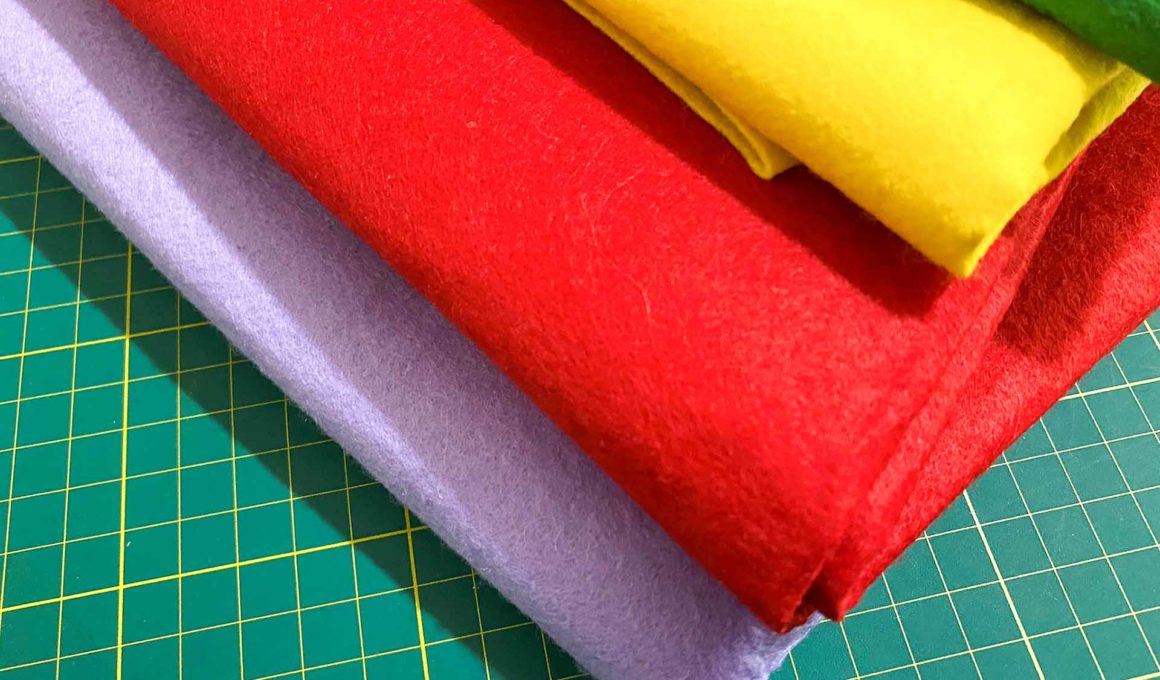Table of Contents
I would guess that most DIY craftspeople have used felt at some point in their lives. But, who remembers things made with felt? When I was little, I loved to put together felt fabric pieces. Felt comes in all shapes, sizes, and qualities here. I’ve put together a guide to choosing the right felt fabric for your project and some helpful tips. Hopefully, it benefits your business.
See Also: Felt Crafts for Beginners – The Complete Guide
Felt is a non-woven, non-woven fabric formed by layers of fibers when needled or exposed to heat. Natural felt can be made from various fibers, including wool, fur, mohair, cotton, rayon, viscose, or other synthetic fibers.
Felt is obtained by the abrasive pouring of the fibers into the rough, hammering the threads, compressing, shrinking, and then applying moisture, varying the temperature, and then applying pressure to the fibers.
Suppose you’re a stitcher or felt artist. In that case, you know you’ll want to have the highest quality felt fabrics available for making your creations professionally or for fun. Of all the different sewing materials available, the felt fabric is one of the most versatile fabrics.
See Also: 11 Questions Every Beginner in Felt Crafts Should Ask
Felt can be used for many different DIY projects. You can use felt in almost any craft project, from children’s crafts to home decor and accessories to clothing. However, selecting the best-felt fabric is more complicated than it appears.
You’ll discover a limitless number of alternatives in any fabric or craft supply store.
Whatever felt DIY project you plan to undertake, you will undoubtedly want to ensure that your finished product is as attractive as possible. To do this, you must choose a genuinely premium quality felt fabric. But unfortunately, not all felt materials are the same.
See Also: Discover 5 Easy Ways to Clean Felt Crafts
But how can you decide which felt is ideal for your DIY projects when there are so many options?
What is Felt Fabric?
Felt is a non-woven textile material. Unlike other fabrics formed by knitting the strands together, felt is made by compressing and matting the fibers from which it is generated to create a solid piece of material.
See Also: What are the Felt Types
Felt fabric can be made from various natural fibers, including wool and fur, or similarly made from artificial fibers such as rayon and acrylic. It is not uncommon for a fiber combination to be used to create felt.
See Also: 4 Types of Craft Felt – Learn to Choose and Use
Felt has been used for centuries; it is the oldest textile known to humans. Many different cultures have legends about the creation of the material. While some cultures still employ traditional felt-making methods, most felt fabrics used today are mass-produced.
What are the Felt Types?
As I mentioned, felt can be made from different types of natural and synthetic fibers. Some of the most common types of felt include:
Natural Wool Felt
Wool felt is made from 100 percent sheep wool fibers, creating a strong, dense, warm, and soft material. It can be purchased as a piece of fabric or cut by hand into more miniature sheets.
Wool felts produced by applying heat, moisture, and compression to the fibers, allowing them to fuse naturally without any binders.
Felt fabrics such as boiled wool, melton, or wool are not genuine felt. Natural felt is made from raw fiber, which felt fabrics are shrunk and filled to produce a felt-like material.
Compared to natural felt, felt fabrics are less dense, durable, knit better, and better suited to tailoring projects. As a result, wool felt is ideal for applications where strength and durability are essential, such as garments or handbags.
Unlike blended wool felt, 100% wool felt, as the name suggests, is made from 100% wool. 100% wool felt comes in a variety of thicknesses. 100% wool felt is sold by sheet or meter and is quite expensive. This felt gives a luxurious feel and is used by professionals such as hatters, fashion accessories, and footwear.
Craft Felt
Craft felts are usually made from 100 percent synthetic fibers such as acrylic, polyester, rayon, or blended materials. It is generally sold in pre-cut squares. It is available in various colors and styles and, as the name suggests, is best used for craft projects. Handmade felt is available online and at major chain stores that carry fabric.
ECO-FI Felt
Eco-fi felt can be defined as an environmentally friendly felt for those who want to reduce their carbon footprint. Eco-fi felt is produced from polyester fiber made from 100 percent recycled plastic. They are similar to craft felt but slightly stiffer. Like craft felt, it is also available in various colors and patterns.
The Eco-fi felt type is usually 100% synthetic. Eco-fi felt is usually acrylic and comes in many colors. It’s commonly accessible in craft stores and on the internet. Most come in pre-cut thin sheets. Eco-fi felt for crafts is also available in glitter sheets, animal prints, and self-adhesive sheets.
Eco-friendly felts made from recycled plastics are similar to acrylic craft felts but are more environmentally friendly. This type of felt is also the perfect craft material because it is rugged, coarse, and waterproof.
Eco-friendly felts can be made from recycled felt, yarn fibers, or leftover carpet fibers. Given the phrase “eco-friendly” in its name, it makes sense that this felt does not use any chemicals or adhesives. Therefore, they are non-toxic and great for children.
How to understand that the felt is of good quality?
In fact, the quality of the fabric depends on the type of felt. Most felt available from retail outlets is acrylic felt or wool felt. Acrylic or glitter felt are ideal for craft projects such as crafts and embellishments.
See Also: 15 Amazing Tips for Working with Felt
This type of felt is very rough and won’t stand up to rolling, so it’s best to buy wool felt if you’re making soft toys and other projects that will take a lot of work. Wool felt usually contains 20-35% wool and is ideal for sturdier craft projects. For example, you can make beautiful bags and hats using wool felt. In addition, wool felt can be used in garments such as collars and cuffs.
The features associated with quality felts are:
- The felt does not unravel, so there is no need to finish a seam.
- Felt is exceptionally durable and simple to sew.
- Do not clean the dry felt in any way! There may be a deformity in this process.
- Felt may flex as it is more susceptible to wear.
- Felt can tear under strain and cannot be easily repaired.
- Those who use felt in clothes, be careful. Felt does not heal well when stretched and can sag on elbows, knees, and sagging!
- Felt may be damaged by steam.
Tips for sewing with felt include:
- Let the felt feed naturally through your machine.
- Do not dry clean!
- Use little or no moisture when ironing. Use a printing cloth.
- Hand wash with mild soap in cold water, then rinse and wring out extra moisture. Wringing or twisting the felt will cause it to lose its shape, so just let it dry.
- For more precision, use a rotary cutter to cut the felt. You can cut felt with scissors, but make sure to use your best fabric scissors.
- Use polyester or cotton thread for felt sewing.
- The needle size is compatible with most needle felts but uses 80/12 to get started.
- 2.5mm- 3.0mm is suitable for the stitch length.
- Use a standard presser foot for the presser foot.
- Press straight seams open for seam surface. No sewing is required as the felt will not unravel.
- Always sew a test seam first.
Finding 100% wool felt can sometimes be quite tricky. That’s why you can also consider making your own felt. Old wool blankets or jumpers are an excellent choice for this. Simply wash your 100% wool fabric in hot water with a mild laundry detergent, rinse the fabric for about 30 minutes, and then dry it in a hot tumble dryer.
DIY Felt Projects and Felt Usage Examples
One of the reasons felt is so attractive is because of its versatility. So if you’re wondering what kind of projects you can make with this durable, colorful, easy-to-work, and relatively inexpensive material, take a look at some suggestions:
These are just a few of the different ways to use felt fabric. Honestly, there are so many other things that can be made from this material. The only thing that will limit you is your mind! So, craft a beautiful collection of durable felt materials and let your creativity take over!
You won’t believe how beautiful things you can make from felt!












